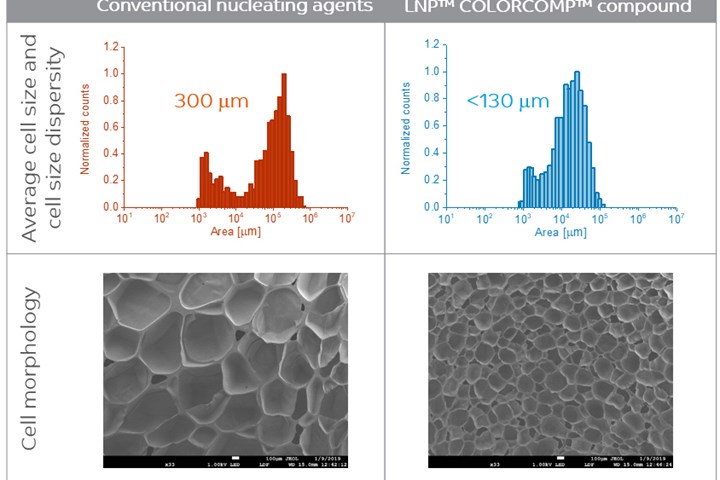First-of-a-Kind Nanotechnology-Based PET Compound Enables Differentiated Foams
SABIC’s new Colorcomp WQ117945 is based on an advanced nanotechnology additive masterbatch that can be adapted to other resins.
A unique PET compound that utilizes an advanced nanotechnology has resulted in the first of its kind material that facilitates efficient production of PET foams for core materials in sandwich structures. Moreover, the nanostructured additive masterbatch used is ‘resin agnostic’ and as such can be adapted to other resins beyond PET making it a good candidate for use in a wide range of different industries, according to SABIC.
LNP Colorcomp WQ117945 compound boasts improved control over nucleation and cell growth, resulting in decreased cell size and uniform, narrower cell size distribution. These attributes reportedly reduce the foam’s weight by minimizing resin uptake in sandwich structures. It can also potentially improve shear strength/strain properties for better fatigue performance. Enhancing PET foams with SABIC’s new LNP Colorcomp compound can address the evolving needs of multiple industries, including marine, building and construction, packaging and wind energy.

Said SABIC’s LNP business development manager, Sunamita Anunciação, “Our novel LNP Colorcomp WQ117945 compound may help to expand adoption of PET foam materials in a wide range of applications, from building insulation and cladding, to boat hulls and decks, to the core of wind turbine blades. In addition to improving PET foam’s mechanical properties, our technology helps reduce weight, which opens new opportunities for sustainability. For example, lighter foam core materials can allow designers to create longer, more-efficient wind blades. Lighter materials also reduce environmental impacts from shipping. Working with our customers, SABIC continues to develop solutions that advance multiple aspects of performance and sustainability.”
According to SABIC, the disposal of wind blades is becoming a global concern because due to their huge size and complexity, most blades are currently sent to landfills. The adoption of PET foams in the core of wind turbine blades offers the industry a strong, light, recyclable option over incumbent materials, such as balsa wood and PVC foam. Weight reduction is also a key issue in wind blade design. Extending blade length to increase the amount of captured energy adds significant weight to the blade. LNP Colorcomp WQ117945 compound reportedlycan significantly reduce foam cell size (as much as three-fold) compared to standard nucleating agents such as talc, while decreasing cell size disparity by a factor of up to five. These factors help to reduce resin uptake by the foam during composite manufacture, resulting in a lighter-weight blade.
In terms of strength and other mechanical properties, high-density PET foams can potentially compete with balsa wood, while avoiding wood’s natural variations. Further, as thermoformable polymers, PET foams offer greater freedom in the design and shaping of wind blades as compared to balsa. They also offer stable supply, cost-effectiveness, consistent material properties and much less resin uptake.
Besides being used as an effective nucleating agent for foaming processes such as extrusion foaming, injection foaming and bead foaming, SABIC’s new nanotechnology solution can also act as a rheological modifier for improving melt strength and thermoformability..
Related Content
-
Fundamentals of Polyethylene – Part 3: Field Failures
Polyethylene parts can fail when an inappropriate density is selected. Let’s look at some examples and examine what happened and why.
-
Prices for All Volume Resins Head Down at End of 2023
Flat-to-downward trajectory for at least this month.
-
Fundamentals of Polyethylene – Part 6: PE Performance
Don’t assume you know everything there is to know about PE because it’s been around so long. Here is yet another example of how the performance of PE is influenced by molecular weight and density.















